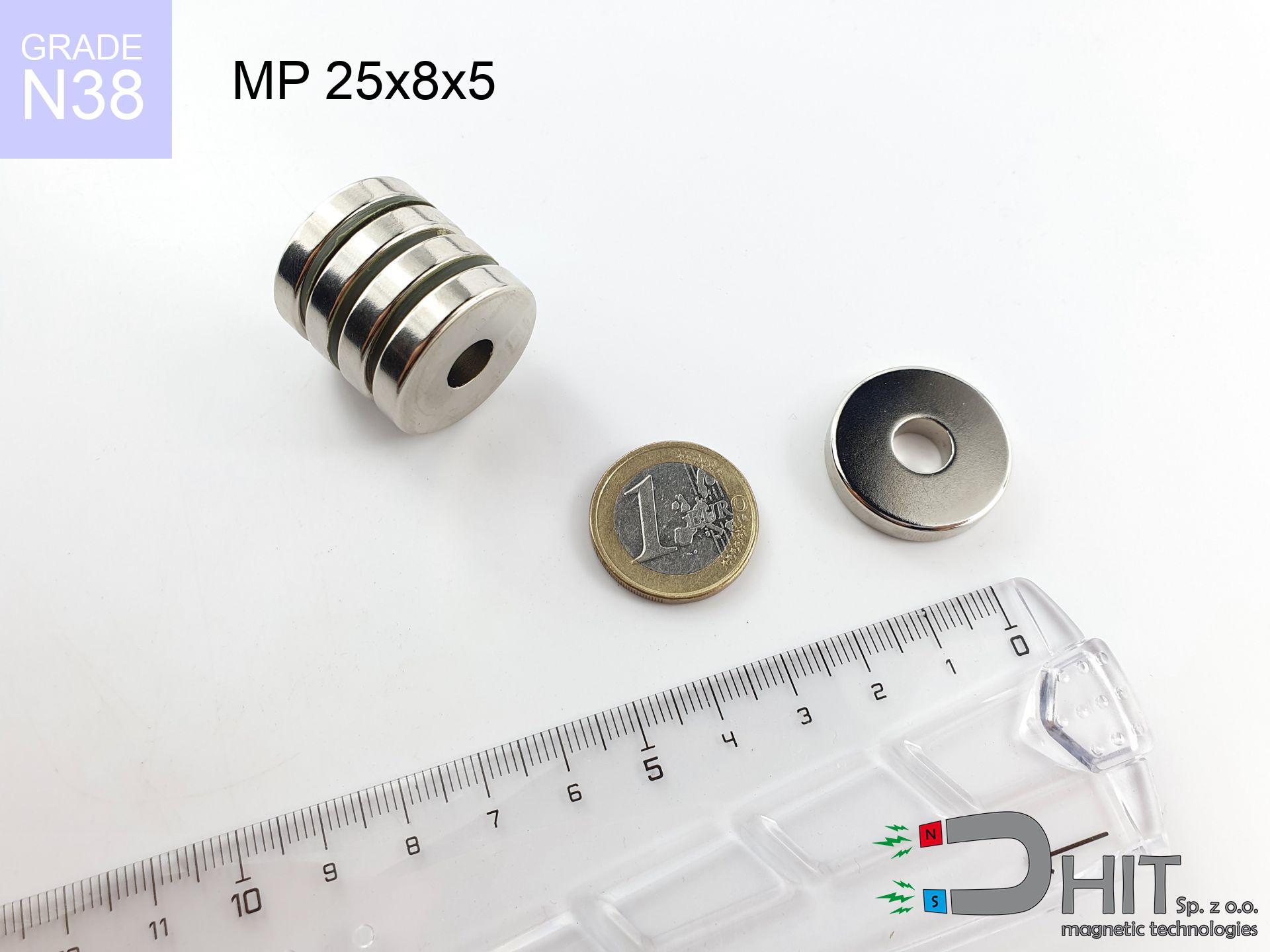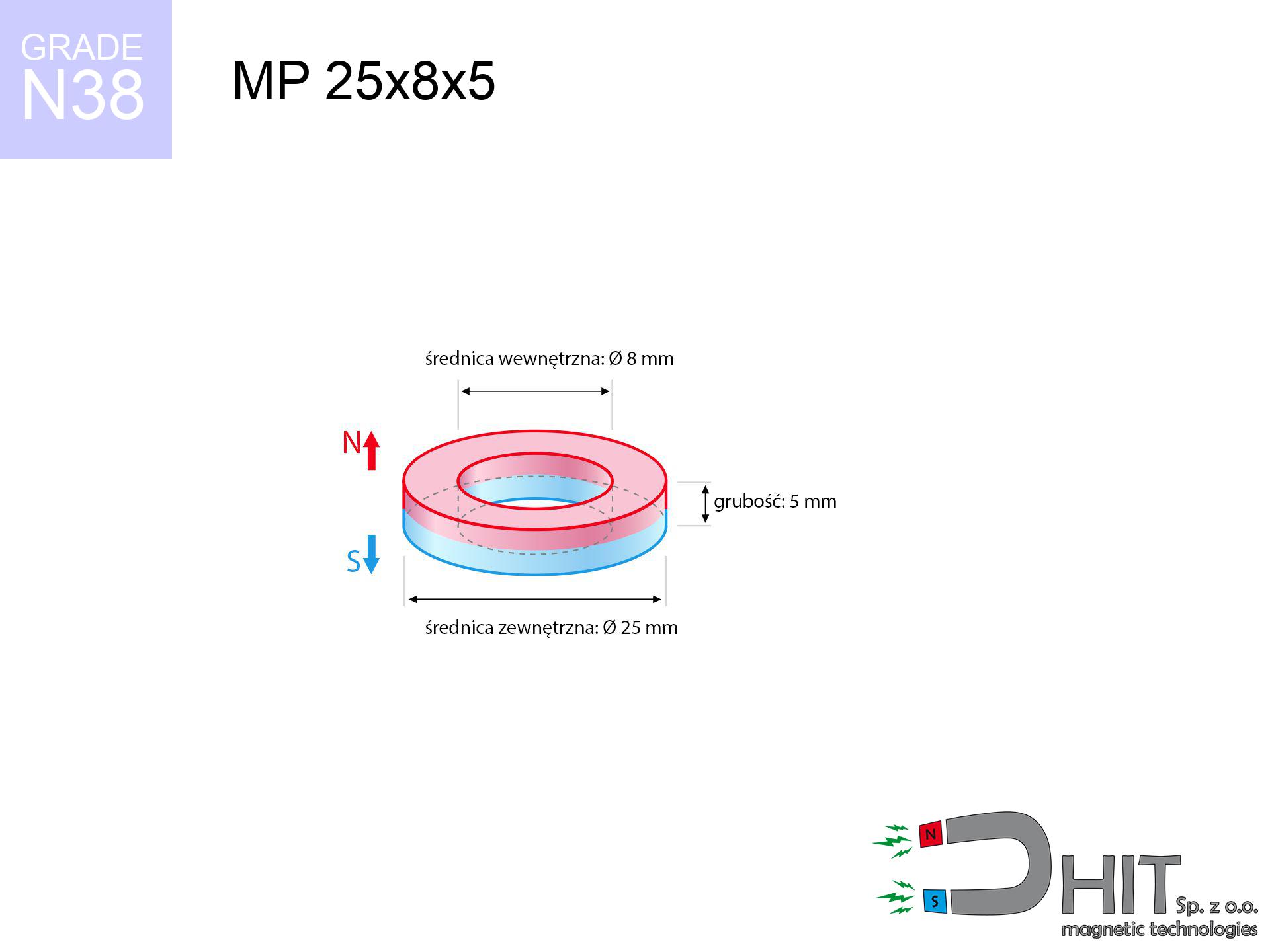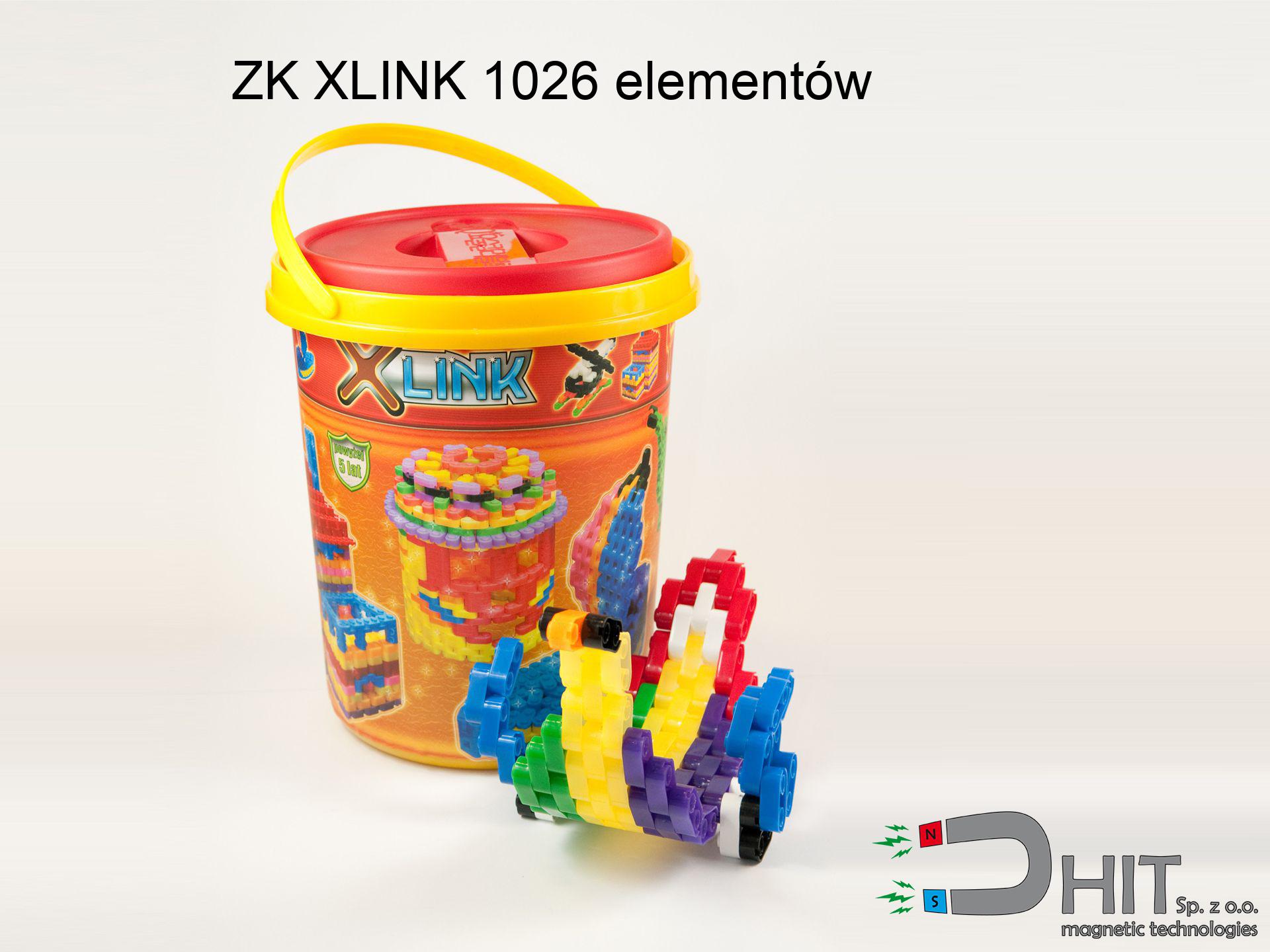MP 25x8x5 / N38 - ring magnet
ring magnet
Catalog no 030196
GTIN: 5906301812135
Diameter [±0,1 mm]
25 mm
internal diameter Ø [±0,1 mm]
8 mm
Height [±0,1 mm]
5 mm
Weight
20.03 g
Magnetization Direction
↑ axial
Load capacity
2.28 kg / 22.36 N
Magnetic Induction
253.21 mT
Coating
[NiCuNi] nickel
5.90 ZŁ with VAT / pcs + price for transport
4.80 ZŁ net + 23% VAT / pcs
bulk discounts:
Need more?Want to negotiate?
Call us
+48 888 99 98 98
if you prefer let us know through
contact form
through our site.
Force along with appearance of neodymium magnets can be analyzed using our
magnetic mass calculator.
Same-day shipping for orders placed before 14:00.
Magnetic properties of material N38
Physical properties of sintered neodymium magnets Nd2Fe14B at 20°C
Shopping tips
Strengths as well as weaknesses of NdFeB magnets.
Besides their immense field intensity, neodymium magnets offer the following advantages:
- They have unchanged lifting capacity, and over more than 10 years their performance decreases symbolically – ~1% (in testing),
- They are extremely resistant to demagnetization induced by external magnetic fields,
- By using a decorative layer of silver, the element has an nice look,
- Magnets possess exceptionally strong magnetic induction on the surface,
- Due to their durability and thermal resistance, neodymium magnets can operate (depending on the shape) even at high temperatures reaching 230°C or more...
- Thanks to freedom in shaping and the capacity to adapt to unusual requirements,
- Key role in future technologies – they are commonly used in HDD drives, drive modules, precision medical tools, and technologically advanced constructions.
- Thanks to efficiency per cm³, small magnets offer high operating force, in miniature format,
Disadvantages of neodymium magnets:
- At very strong impacts they can crack, therefore we recommend placing them in steel cases. A metal housing provides additional protection against damage, as well as increases the magnet's durability.
- When exposed to high temperature, neodymium magnets suffer a drop in force. Often, when the temperature exceeds 80°C, their strength decreases (depending on the size and shape of the magnet). For those who need magnets for extreme conditions, we offer [AH] versions withstanding up to 230°C
- Due to the susceptibility of magnets to corrosion in a humid environment, we advise using waterproof magnets made of rubber, plastic or other material immune to moisture, in case of application outdoors
- Due to limitations in creating threads and complicated forms in magnets, we propose using a housing - magnetic holder.
- Potential hazard to health – tiny shards of magnets are risky, when accidentally swallowed, which gains importance in the context of child safety. Furthermore, small elements of these products can disrupt the diagnostic process medical when they are in the body.
- With budget limitations the cost of neodymium magnets is a challenge,
Highest magnetic holding force – what it depends on?
Breakaway force was determined for the most favorable conditions, taking into account:
- with the application of a sheet made of low-carbon steel, guaranteeing maximum field concentration
- possessing a thickness of minimum 10 mm to avoid saturation
- with a surface free of scratches
- with total lack of distance (no impurities)
- during pulling in a direction perpendicular to the mounting surface
- in temp. approx. 20°C
What influences lifting capacity in practice
It is worth knowing that the magnet holding may be lower influenced by elements below, in order of importance:
- Gap between surfaces – even a fraction of a millimeter of separation (caused e.g. by veneer or dirt) diminishes the magnet efficiency, often by half at just 0.5 mm.
- Load vector – maximum parameter is obtained only during perpendicular pulling. The force required to slide of the magnet along the plate is typically several times smaller (approx. 1/5 of the lifting capacity).
- Substrate thickness – for full efficiency, the steel must be sufficiently thick. Thin sheet restricts the attraction force (the magnet "punches through" it).
- Steel grade – ideal substrate is pure iron steel. Cast iron may have worse magnetic properties.
- Base smoothness – the more even the surface, the better the adhesion and higher the lifting capacity. Unevenness acts like micro-gaps.
- Temperature – heating the magnet results in weakening of induction. Check the thermal limit for a given model.
* Lifting capacity was assessed with the use of a smooth steel plate of suitable thickness (min. 20 mm), under perpendicular detachment force, in contrast under attempts to slide the magnet the load capacity is reduced by as much as fivefold. In addition, even a small distance {between} the magnet and the plate lowers the holding force.
H&S for magnets
Warning for heart patients
Warning for patients: Strong magnetic fields affect medical devices. Keep at least 30 cm distance or ask another person to handle the magnets.
GPS and phone interference
Navigation devices and mobile phones are highly susceptible to magnetic fields. Direct contact with a strong magnet can decalibrate the sensors in your phone.
Do not give to children
Only for adults. Small elements pose a choking risk, leading to serious injuries. Keep away from children and animals.
Immense force
Handle magnets with awareness. Their huge power can surprise even professionals. Plan your moves and do not underestimate their force.
Risk of cracking
Despite the nickel coating, the material is delicate and not impact-resistant. Do not hit, as the magnet may shatter into sharp, dangerous pieces.
Dust is flammable
Powder created during cutting of magnets is combustible. Do not drill into magnets without proper cooling and knowledge.
Do not overheat magnets
Watch the temperature. Heating the magnet to high heat will destroy its magnetic structure and pulling force.
Electronic hazard
Powerful magnetic fields can corrupt files on credit cards, HDDs, and other magnetic media. Stay away of min. 10 cm.
Physical harm
Large magnets can smash fingers in a fraction of a second. Under no circumstances place your hand betwixt two strong magnets.
Metal Allergy
Allergy Notice: The Ni-Cu-Ni coating contains nickel. If redness appears, immediately stop handling magnets and wear gloves.
Safety First!
Learn more about hazards in the article: Safety of working with magnets.









